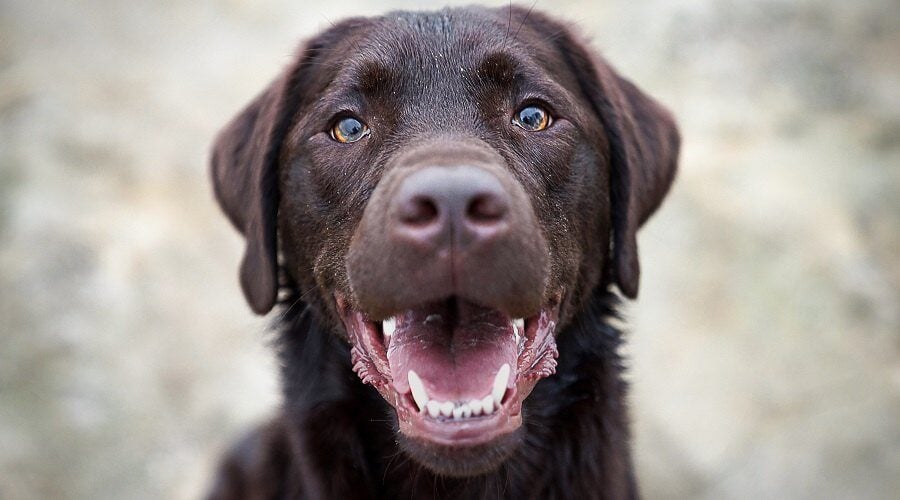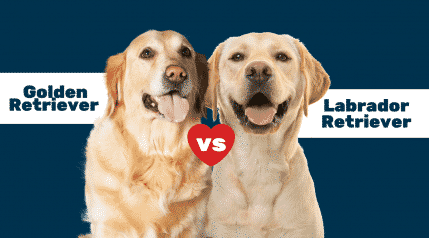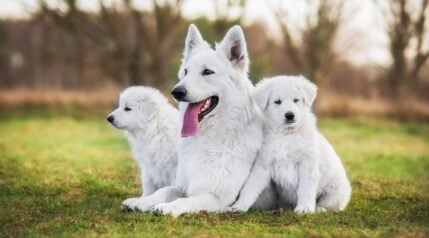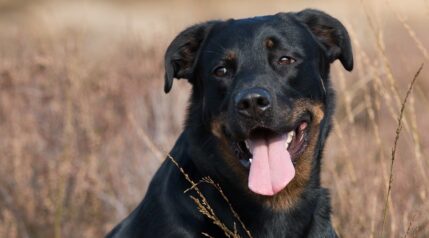The Labrador Retriever has been the number one choice of pet dog for families in the U.S. for many years. Number two in that comparison is the GSD. That’s not surprising, given that Labs have the perfect temperament and personality to be a wonderful family dog.
Like the Golden Retriever, Labrador Retrievers are friendly, affectionate, and outgoing. They’re intelligent and trainable too. And, as long as you socialize your Labrador Retriever puppy properly, these pups will get along fine with other dogs and cats also.
A Lab would make the ideal addition to an active family, as these dogs are bred to work, and they do need plenty of exercise to keep them fit physically and happy mentally. That’s an important consideration, as a bored Lab can become very destructive around your home.
In this guide, we’ve provided you with all the information you’ll need to make the right decision. And we’ve also included some ideas on where you can find your perfect Labrador Retriever puppy. So, would a Labrador Retriever make the ideal furry addition to your household? Let’s find out!
History

The Labrador Retriever was first seen in Newfoundland, Canada. At that time, the breed was called the lesser Newfoundland, the St. John’s dog, or the St. John’s Newfoundland, most likely to avoid confusion between the Lab and the giant Newfoundland.
There are two theories on how the breed came by his current name, the Labrador. One idea is that the name comes from the Spanish word, “labrador,” meaning laborer. That would be an appropriate choice of moniker, given the breed’s working history.
At one time, these dogs worked alongside Portuguese fishermen who trawled the Grand Banks area off the coast of Newfoundland and Labrador. The dogs were used to fetch items from the water, including full fishing nets. Also, the Lab was used to carry messages from boat to boat by swimming between the craft.
The Labrador Retriever was also known for his keen sense of smell, his uncanny ability to locate downed game birds, and his speed across uneven terrain and through the water. Some Labs were taken back to England, where they quickly became a favorite of the Earl of Malmesbury who employed the dogs to work with huntsmen in the swampland around his country estate.
The Earl’s son began to breed the dogs and christened them Labrador Retrievers. In England, the Kennel Club officially recognized the breed in 1903.
The Labrador Retriever arrived in North America early in the 20th century when the breed was imported by sportsmen who favored the dogs’ versatility and unrivaled work ethic.
The modern Labrador Retriever is a member of the Sporting Group. The breed is still a sporting icon with shooters, and Labrador Retrievers can often be seen on pheasant shoots and duck hunting outings. Also, Labrador Retrievers have found a place as working dogs, taking a role in many different sectors, including:
- Guide dogs
- Show ring stars
- Service dogs
- Assistance dogs
- Detection dogs
- Therapy dogs
- Search and rescue dogs
Labs have even been trained to work alongside medical staff, detecting many different forms of early-stage cancer, and saving a lot of lives in the process.
Temperament

Labrador Retrievers are known to be social and trusting pups. They can be quite mischievous, even into adulthood, and are always up to play for endless hours. These pooches make great companions to children and make loyal additions to any family. It is very uncommon for a Lab to meet a person it didn’t like!
Labs are also widely known to make lousy guard dogs. While they may bark at a stranger, they will almost always soften up for a pat on the head, even from strangers! Don’t let a barky first impression fool you! They are some of the most easy-going dogs out there.
A Lab’s outgoing, energetic, and happy demeanor is the main reason he is America’s #1 favorite dog breed! a healthy Lab should never snap at anyone or show any aggression. Instead, he will offer snuggles and kisses. They also do well with other housepets.
Size & Appearance
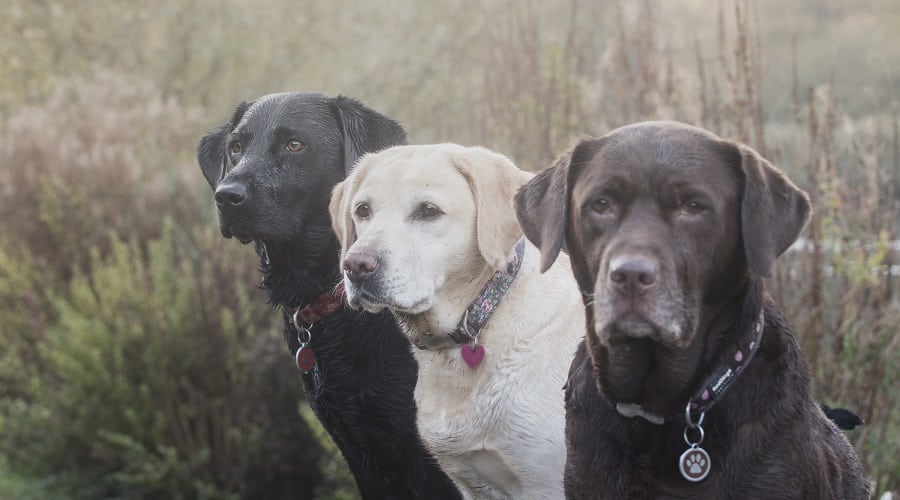
Labrador Retrievers are large dogs! Labs vary in size from 21.5 to 24.5 inches tall at the shoulder, weighing in at between 55 and 90 pounds. Females are generally slightly smaller and more lightly built than male Labrador Retrievers. Bench Labs are bigger than field labs, so that’s also something to consider when buying from a breeder. Check out our Labrador Retriever Growth Chart to learn more.
Labradors can be black, chocolate, or yellow. They can also be red, or even silver. Labs have a double coat that consists of a soft, fluffy layer of underfur topped by a short, hard, outer layer of guard hairs. Labs are heavy shedders, making them a poor choice for your household if you have allergy sufferers living there.
Exercise Requirements

Labrador Retrievers are traditionally a working breed, and as such, they need lots of exercise. Labs are notoriously greedy dogs, and if not given enough exercise, they can become overweight.
Obese Labs can suffer from weight-related health problems, so always be sure to keep your dog in good condition and give him plenty of exercise. You should give your Labrador Retriever at least two long walks every day and some playtime at home too if possible.
Labradors are full of energy that needs to be burned off every day. This need for an energy release as well as the propensity to become obese means you should exercise your Lab for about 2 hours each day. This doesn’t mean a brisk walk around the neighborhood! He needs a play session at the park or playing with other dogs. This way, he can be mentally stimulated as well.
Living Conditions

A Labrador Retriever should live inside with a cozy dog crate to call his own. Some crate models are better suited for Labradors than others. When your dog is outside, ensure he has a place to go that’s shaded from the sun while having unlimited access to fresh water. These dogs are very family-oriented and won’t thrive if isolated from their human pack.
Training

Labrador Retrievers are intelligent, highly trainable dogs who are always eager to please their owner. Labs are very powerful, strong dogs with naturally high levels of energy. For that reason, early socialization of your puppy is essential.
If you take the time to introduce your new puppy to lots of different situations, locations, and people in his early weeks, you’ll set him up to be a confident, well-adjusted dog in adulthood. Just be sure to wait until your puppy has had his full course of vaccinations before you begin introducing him to other dogs.
Obedience training and puppy classes are critical elements of the socialization process. If you plan to harness train, make sure to use a harness made for Labradors, or large breeds.
Health

A healthy Labrador Retriever has an average life expectancy of between 10 and 12 years. Labs are generally healthy dogs, but they do suffer from a few genetic health conditions.
Hip Dysplasia: This is a genetic condition that affects the dog’s hip joint, causing it to become malformed. The deformity causes the bone to degenerate, leaving the dog with painful arthritis. Hip dysplasia can be treated surgically if necessary, and milder cases can be managed with drug therapy and a comfortable Labrador dog bed. Always ask a breeder for certification that the parents & grandparents have been screened for this disease.
Elbow Dysplasia: Elbow dysplasia is an inherited condition that causes abnormal development of the structures within the elbow joint, particularly involving the cartilage and surrounding structures. As the disease progresses, the joint develops painful osteoarthritis.
Progressive Retinal Atrophy: Progressive Retinal Atrophy (P.R.A.) is the name given to a group of degenerative diseases that affect the photoreceptor cells of the eye. Atrophy simply means deterioration or wasting of these cells, eventually causing blindness.
Cataracts: Cataracts are imperfections in the eye’s lens. A cataract prevents the eye’s lens from focusing light, causing the lens to become opaque, rather than transparent. That leaves the dog with partially reduced sight in the affected eye. Some cataracts are tiny and cause little or no problems for the dog. However, more significant cataracts can cover the whole of the lens, leaving the animal blind or at best partially sighted.
Osteochondritis: Osteochondritis is a condition that commonly affects young, rapidly growing dogs. The surfaces of the dog’s joints fail to form bone in particular areas and thickened cartilage results. In weakened areas, the cartilage detaches from the healthy tissue around it and creates a flap. The cartilage flap can sometimes detach itself from the surface of the joint, which leads to the development of secondary osteoarthritis.
Degenerative ACL/Tendon Conditions: As well as genetic conditions, very active Labrador Retrievers can suffer from soft tissue injuries, including anterior cruciate ligament (ACL) tears.
Be Prepared
Because they are prone to health issues, we recommend looking into pet insurance for your lab, ideally at a young age. You should also ask your breeder for a copy of their health certification. There’s a smaller risk of health conditions if the parents have been health certified. The Labrador Retriever Club insists that all dogs registered on the Canine Health Information Center (CHIC) database have hip and elbow certifications from the Orthopedic Foundation for Animals (O.F.A.) and certification from the Canine Eye Registry Foundation (C.E.R.F.).
Nutrition

Choose a high-quality dog food for your Labrador Retriever and feed him a diet that’s appropriate to your dog’s age, i.e., puppy, adult, or senior and also make sure you are feeding the right amount. You can use treats as a training aid, but be careful not to overdo them, as Labrador Retrievers are prone to weight gain. If your Lab gains weight, you’ll want to put your pup on an exercise plan and feed them food that will help them lose weight.
When you collect your puppy, ask the breeder what kind of food the pup was having, and stick to the same brand for the first six months or so. When your puppy is old enough, move him onto adult food. For more information and advice on feeding your Labrador Retriever, have a chat with your local vet.
Grooming

Labs shed a lot! For that reason, you’ll need to spend time at least twice a week brushing your Labrador Retriever to keep the hair shedding under control. The best grooming tools to use on your Lab are a slicker brush and a Furminator de-shedding tool.
Your Lab will probably shed more heavily twice a year during the spring and fall when he changes his undercoat in line with the new season. During the times your lab sheds most, it may be worth looking in an anti-shed dog shampoo. Labs are known to have sensitive skin, so keep that in mind when bathing your pup.
Labrador Retrievers love to swim. When your dog has taken a dip in a lake or the ocean, be sure to rinse his coat thoroughly to remove any salt or dirt that could dry out his skin. Also, make sure that you dry your Lab’s ears after a swim to reduce the risk of infection.
Breeders & Puppy Costs
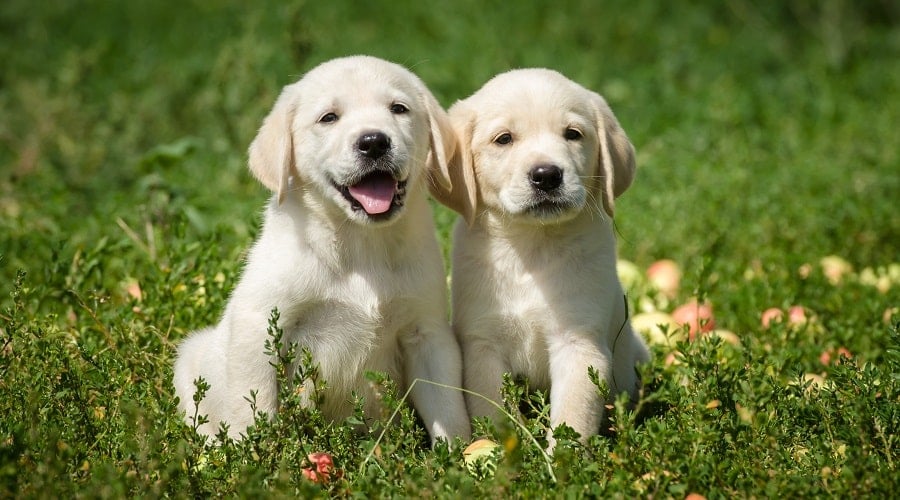
So, now you’ve decided that a Labrador Retriever would make the ideal canine addition to your family, you’ll need to know where to start your search for a puppy.
The price you’ll pay for a Labrador Retriever puppy depends on several factors, including where you live in the country, the sex of the puppy, and any accolades that have been won by the puppy’s parents or grandparents.
You can usually buy a well-bred Labrador Retriever puppy for around $800 to $1,200. The puppy you buy should come with a temperament test certificate, vet’s certificate, and the pup’s parents’ health certifications. The puppy should also have been wormed, and his series of vaccinations started.
A good place to begin your search for a Labrador Retriever puppy is on the website of the Labrador Retriever Club, Inc. Here, you’ll find listings of reputable Labrador Retriever breeders located in different regions right across the U.S.
Also, the website of the American Kennel Club lists good breeders who may have some well-bred Labrador Retriever puppies for sale. You could also check out the National Labrador Retriever Club for referrals and contact information for reputable breeders.
Beware of buying a cheap Labrador Retriever puppy! If a pup is offered for a rock bottom price, he’s probably come from a backyard breeder or a puppy mill. Avoid puppy mills like the plague!
Puppy mills breed puppies on an industrial scale, and little regard is given to health screening. The conditions in which the breeding dogs are kept are usually very poor, and many of the puppies are either born with health defects or become sick because of the unsanitary environment into which they’re born. It’s well worth noting that many small downtown pet stores source their stock from puppy mills.
Rescues & Shelters

Sadly, there are lots of adult Labrador Retrievers to be found in rescue centers and shelters across the country. If you would be happy to offer a forever home to an unwanted adult Labrador Retriever, you could try searching for a suitable dog in one of the many rescue centers and shelters around the country.
The Labrador Club of America has a rescue network that may be able to find you a Lab that would make the perfect companion for you and your family, so that’s a promising place to begin searching.
However, you should proceed with caution when taking a dog from a shelter. Many times, a shelter or rescue center won’t have a full history for their dogs. So, the Labrador Retriever you’re considering as your family pet could have a checkered past, poor health, and even temperament issues.
These days, many shelters acknowledge the concerns of would-be adopters and offer potential owners the chance to take a dog on a trial basis for a month or so. That’s a great idea, as it allows you to see how well your chosen Labrador Retriever settles into his new environment.
As Family Pets

So, now you know more about the Labrador Retriever, would one of these friendly, outgoing, non-aggressive dogs make an excellent addition to your household? Here’s a quick rundown of the most important aspects of owning a Labrador Retriever.
- Labrador Retrievers are quite big dogs.
- Labs can function in an apartment but do better with a yard.
- If you live in a smaller space, exercise your lab daily.
- Labrador Retrievers have a double coat, and they are heavy shedders.
- So, you will need plenty of time to spare for grooming your Lab.
- Labs aren’t great for allergy sufferers. Stick to hypoallergenic dog breeds.
- The Lab is a friendly, sociable dog who loves everyone.
- These are big dogs, so be cautious if you have small children around.
- The Labrador Retriever was bred to work.
- These pups do best in an active home where they’ll get plenty of exercise.
- Labs are perfect as hunting and sporting dogs.
- Labs love to eat. Food regulation is important to prevent weight gain.
- Labs do have a double coat that keeps them warm in cold weather.
- This is a highly social breed that needs to be near family.
- Labs should be inside dogs, not an outside breed.
- When compared to other breeds like the Husky, these pups are affectionate.
So, a Labrador Retriever would make an ideal family dog if you have a large house with a backyard and you and your family enjoy an active, outdoorsy lifestyle. A well-socialized Labrador Retriever will happily settle into a busy, family-oriented environment with other pets too.
Popular Lab Mixes

Because of their endearing nature, Labradors are popular “designer dogs” that mix with other breeds. Here is a non exhaustive list of some very popular Labrador Retriever mixes you are likely to come across.
- Pit bulls and Labs combine to make Labrabulls
- Corgis and Labs combine to make Corgidors
- German Shepherds and Labs combine to make Shepradors
- Blue Heelers and Labs combine to make Labraheelers
- Siberian Huskies and Labs combine to make Huskadors
- Mixed with a Beagle to create the Beagador
- The Mini Labradoodle
- The Dachshund Labrador Mix
- Aussiedor
- Borador
- Boxador
- Pyrador
- Mastadors
All About Labs From Our Readers
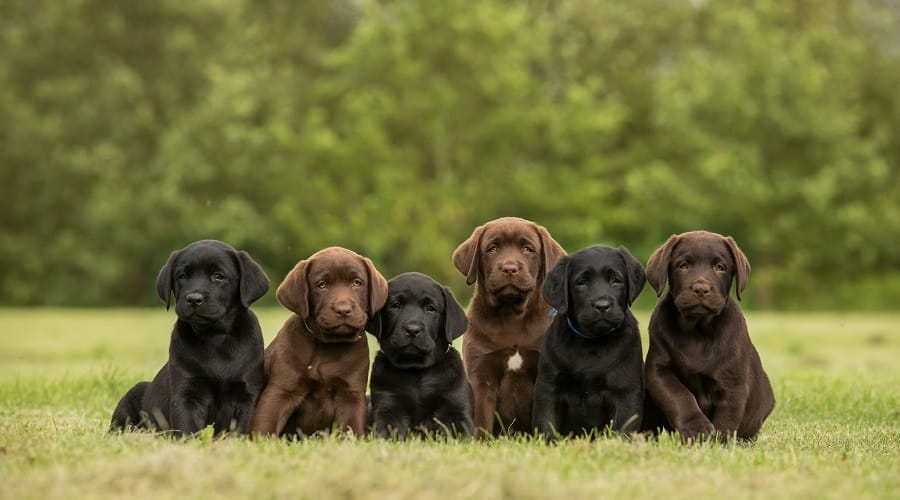
In the past, our readers shared their thoughts about their beloved Labradors with the site founder, Janet Wall. To keep the integrity of this page, we wanted to share these heartfelt messages from the kids.
“Labradors [make] lousy watchdogs. They usually bark when there is a stranger about, but it is an expression of unmitigated joy at the chance to meet somebody new, not a warning.” – Norman Strung
“My yellow Labrador Retriever, Oliver or Ollie, has a very funny personality. Like he’ll sneeze a lot or chase his tail. His favorite toy is an old stuffed Barney, but whenever we get home from somewhere we’ll find him sleeping on his back with his legs up in the air and he’ll have a smile on even when he’s sleeping.
It’s so cute – he is the best dog EVER.” Kiersten, age 10, New Jersey, USA
“I love Myffy (Labrador Retriever) because he is a cute little pup. I hope he will grow up to be an
intelligent and responsible dog. He loves to play with me and enjoys running around”. Anupama, Age 11, New Delhi, India
“We have two Labradors. Our first dog, Max Million, he looks like a big bear. Our second dog Maddie, looks like a Salamander, because she lays on her tum tum with her legs spread out!” Anonymous, ages 11 and 9, Washington USA
“I have some dogs too! Yeller (named after Old Yeller). He is a yellow Labrador Retriever and very obedient. He is 6 years old and he has mellowed out a whole bunch! I got him when he was a puppy.
He can be very cute and cuddly at times!” Kara
“I have a black Lab. His name is Chivas. I had another dog but she died. Her name was Bailey. She was a
yellow Lab. I also had a chocolate Lab. His name was Captain. We had to give him away, because he
kept on digging out. I want another dog so that my dog can have a playmate.” Kimberly, Age 9
“My Lab, Mac, is so cute. He is three months old and loves to chew on things. He is a purebred yellow Lab.” Kelsey, Age 12, Florida USA
“My dog’s name is Chewbacca and his nickname is Chewy (chocolate Labrador Retriever). He is going to turn one in like three days. I got him last June and he was a cutie. I love Labradors a lot! He is one of my best friends!” Laura, Age 13, Nebraska USA
“I have a yellow Lab named Haley. She is 2 years old and very sweet! She loves to take walks with me and
likes to play fetch. She can do lots of tricks, one of her favorites is jumping through a hula-hoop. Haley is one of my best friends. I will always love her!” Jeanette, Age 12, Wyoming USA
“I got my dog, Niki (black Labrador Retriever), on Christmas Day. I very surprised that I would get a dog.
She is very good. She is also a lot of fun at 12 weeks old. This summer I’m going to teach her how to swim. She is going to be a lot of fun this summer.” Alyssa, Age 8, New Hampshire USA
“Our dogs (Labrador Retrievers) are very sweet. They love to play ball. We love them very much and
take good care of them. Max is so intense about the ball and he sleeps on Jessi’s bed. Maddie snuggles when she is tired. She also snuggles on Candi’s bed and is a two-second puppy’. ‘Two-second puppy’ means that she only wants to snuggle two seconds when she is awake.” Candis and Jessi, ages 10 and 8, Washington USA
“My dog, Sunny (Labrador Retriever), was very nice. She’s very polite, too. When we went up to the mountains (2 hour drive), she didn’t throw up or poop. But still, she was very funny whenever we went swimming. She also enjoyed baths, so I guess that’s one good thing about a dog.” Kati, Age 11, California USA
“My dogs (yellow Labrador Retrievers) are so nice. I love them because they are part of our family. They are special because they always love me no matter what. My dogs are related to each other. Dakota is Lady’s dad.” Kaylah, Age 7, California
“Hi Doggie lovers! You wanna know something cool about my dog Gracey (Chocolate lab)!? Her real name is Gelya (Gail-ya). I mean her first name is Gelya. Her middle name is Gracey. We call her by her middle name. She does this hilarious thing. Every once and a while she’ll roll on her back, all over the floor like a nut! And when she’s tired, she’ll go into our computer room and she’ll flop on the couch & fall asleep! Plus she snores. But she only does it on the couch in the computer room! Nowhere else! I’ve written a ton of stuff on this site. Look for it! Well, gotta go! See ya on the web!” Adnama, Age 9, Massachusetts USA
“Hi, my name is Tawny and I have a black lab and her name is Casey. Casey is a female puppy and she is very playful. She is only 10 weeks old and she does not get along with my cat, Mitsy or my kitten, Kali. Casey loves all of her toys especially her squeaky white teddy bear.” Tawny, Age 10, California USA
“Hi. I have a dog named Casey. She is a black Lab. Once I got in big trouble by my mom and she yelled at me and I started to cry. I was laying on the floor and she (Casey) came to me and laid next to me and started licking my face. Casey is a 1-year-old and as cute as can be!” Courtney, Age 11, Illinois USA
“Hi my name is Amanda. I have a dog, her name is Casey. She is very cute. She can jump very high. Her favorite toy is a squeaky teddy bear. She is a very funny puppy. She loves to play with me and my sister. Maybe you think black Labradors like water, but Casey doesn’t. I love her very much!” Amanda, Age 8, California USA
“I love my dog (a Black Labrador). He’s adorable. He loves to swim at the Lake. He likes going on walks
and going bye-bye. We took him to the car wash once and he barked up a storm. When we got out everyone was looking at us. His name is Jake. He weighs 120 pounds. I love my dog. I will always love my dog, even if he is rambunctious and chews up underwear. I’ll always keep my dog and not ever sell him for all the money in the world. When I grow up, I’m going to own a kennel. I wish that I could have every dog in the world. Even if they were ugly, I’d still love them.” Amanda, Age 11, Ohio USA
“I taught my dog, Rosie (black Lab), to sit, give me her paw, and whisper, and I taught her to lay down and roll over and play dead. And once I brought her to a pond to swim and she cut her foot on something we brought to the hospital. She loves to chase cats and lick my face and lick the food out of the cat food can. And once she dug a hole 5 feet deep and the cats fell into it.” Samantha, Age 10, Maine USA
“My dog, Tucker, (yellow Lab) is 3 years old. He is really cute and I love him because he’s smart, very playful, and always greets you when you get back from school. He also knows a lot of tricks like high five, bye-bye, Air Bud, and much more. He’s such a good pup I wouldn’t give any dog in the world for him. He loves being around people, especially kids. When we go somewhere in the car, he’s always the first one in.
He sits beside me and puts his head on my shoulder. Every year at our trailer, there are fireworks. He gets really scared and hides in the car and refuses to come out when it is over. He also thinks the same of thunderstorms.” Julia, Age 8, Oshawa, Ontario, Canada
“I love my dog, Coco (Labrador Retriever), because he makes the cutest faces and he barks when there’s
someone or another animal around. He likes to come swimming with me when it’s warm and he is always very playful.” Jocelyn, age 11, Ontario Canada
Final Thoughts
If you’re looking for a dog with a friendly, affectionate nature who gets along great with kids, other dogs, and the family cat, the sociable, outgoing Labrador Retriever could be the perfect choice for you.
Labrador Retrievers shed more heavily than your average dog, so it may not be a good choice for a household with allergy sufferers. And you’ll need to put aside plenty of time to groom your Lab.
Labradors need plenty of exercise and happily participate in canine sports such as dock diving and obedience classes. And if you enjoy shooting, a Labrador Retriever will make the perfect companion on your hunting expeditions.

